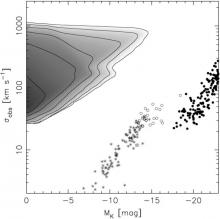
Abstract
A supermassive black hole ejected from the center of a galaxy by gravitational wave recoil carries a retinue of bound stars - a "hypercompact stellar system" (HCSS). The numbers and properties of HCSSs contain information about the merger histories of galaxies, the late evolution of binary black holes, and the distribution of gravitational-wave kicks. We relate the structural properties of HCSSs to the properties of their host galaxies, in two regimes: collisional, i.e. short nuclear relaxation times; and collisionless, i.e. long nuclear relaxtion times. HCSSs are expected to be similar in size and luminosity to globular clusters but in extreme cases (large galaxies, moderate kicks) their stellar mass can approach that of UCDs. However they differ from all known classes of compact stellar system in having very high internal velocity dispersions. The absorption-line spectrum of a HCSS mimics that of a normal E-galaxy with a velocity dispersion that is a fraction ~0.25 of the kick velocity, or as great as ~1000 km/s. The line-of-sight velocity distribution of a HCSS is extremely non-Gaussian due to the presence of stars with a wide range of velocities, all of which would appear together in the spectrograph slit. We combine a hierarchical merger algorithm with stellar population models to compute the rate of production of HCSSs over time and the probability of observing HCSSs in the local universe as a function of their apparent magnitude, color, size and velocity dispersion, under two assumptions about the star formation history prior to the kick. We predict that roughly 100 HCSSs should be detectable within 2 Mpc of the center of the Virgo cluster and that many of these should be bright enough that their high internal velocity dispersions could be measured with reasonable exposure times.